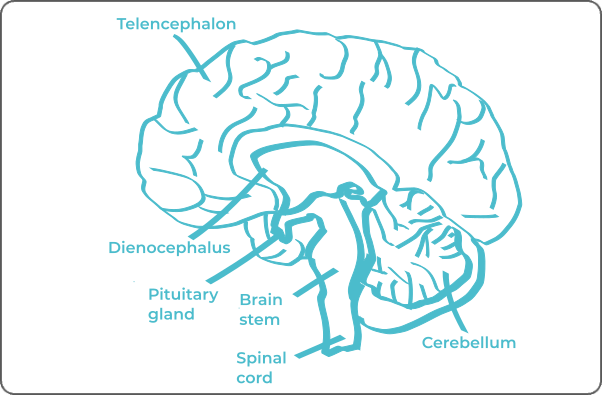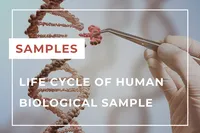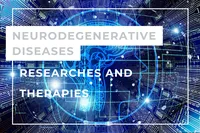Home › Biological sample › Cancer › Brain
Brain cancer biological samples
For Research and Development
The development of drugs and diagnostic tests for the treatment and detection of brain cancer requires conducting studies on biological samples obtained from patients with brain cancer.
A brief overview of the various types of brain cancers and how the services offered by Labtoo contribute to accelerating research and development projects in the pharmaceutical industry.


Are you looking for biological samples from brain cancer patients?
What are brain tumors?
In the brain, a distinction is made between primary and secondary tumors. Primary tumors originate within the brain, whereas secondary tumors are metastases from pre-existing cancers, often originating from the lung, skin, kidney, or breast, which have migrated to the brain. Whether benign (2/3) or malignant (1/3), brain tumors can have pathological implications depending on their location.
The main types of primary tumors include:
Gliomas
They constitute all cancers arising from glial cells. Subtypes include astrocytomas, derived from astrocytes, and oligodendrogliomas, derived from oligodendrocytes.
Grade 3 glioma is referred to as anaplastic glioma, while grade 4 is known as glioblastoma.
Meningiomas
Tumors of meningeal origin, often benign, represent about 30% of primary brain tumors.
Medulloblastomas
Tumors emanating from granular cells of the cerebellum. Although more common in children, accounting for 30% of primary brain tumors, they can also affect adults.
Neurinomas (or Schwannomas)
Benign tumors representing approximately 8% of primitive brain tumors.
They develop from Schwann cells that form a sheath around nerves. Typically, these tumors form along the auditory nerve, referred to as acoustic neuroma.
| Cancer Type | Cellular Origin | Frequency |
|---|---|---|
| Gliomas | Glial cells | ≈ 33% |
| Meningiomas | Meninges | ≈ 35% |
| Medulloblastomas | Cerebellar cells | ≈ 15% |
| Neurinomas | Vestibulocochlear nerve | ≈ 8% |
| Germinomas (CNS GCT) | Germinal cells | ≈ 5% |
| Ependymomas | Ependymal cells | ≈ 4% |

Metastases of brain tumors are rare and have a low incidence.
Explore Labtoo's Service for Your Biological Sample Research
Labtoo assists you in sourcing biological samples from brain cancer patients. Our team manages the entire project of transferring biological materials from inception to sample delivery.
- Feasibility assessment of sample availability or clinical collection from referenced clinical centers
- Validation of regulatory aspects
- Establishment of a contractual framework
- Dispatch of desired samples under appropriate conditions
- Transfer of associated clinical data
- Additional analytical and experimental services
Types of available samples
Fresh tissues
After a tumor resection or a biopsy, a pathologist can decide whether the tissue sample can be used for research. Labtoo can organize the conditioning and shipment of fresh brain cancer tissue in 24-48 hours after surgery.
Frozen tissues (OCT and FF)
Similarly to fresh tissue, once the tissues are cleared for research, the clinical site can freeze and keep the frozen brain cancer tissue samples at -80°C or in liquid nitrogen for ulterior use.
FFPE Tissues
Pathologists typically embed the biopsies and resections in paraffin. FFPE blocks of brain cancer tissues can be used later for research.
Adjacent Healthy Tissues
Tumor resections typically include healthy adjacent brain tissue during the process. This tissue can later be used for research and act as controls for diseased tissues.
- Plasma or Serum from brain cancer patients
- PBMC (Peripheral Blood Mononuclear Cells)
- Whole Blood
- Leukapheresis
- Urine
- Feces
- Cerebrospinal fluid
- Other
Typical associated clinical data
-
- Age
- Gender
- Ethnicity
- TNM Classification
- Undergone Treatment
- Medical Imaging
- Serology
- Mutations
- Other Data (upon request)

Labtoo identifies clinical sites that can prepare and transfer sample collections tailored to your specific project needs.
Contact our team to discuss your project.
Send your request to our team:
The stages and grades of brain cancer
The stage and grade of cancer are commonly used in conjunction to provide a comprehensive assessment of the disease and guide optimal treatment.
Determining the stage of cancer relies primarily on the TNM classification, which evaluates the tumor size (T), involvement of lymph nodes by cancer cells (N), and the presence of metastases in other parts of the body (M). Concurrently, the grade indicates the degree of differentiation of cancer cells.
Unlike most other cancers, it is the concept of grade that is more extensively utilized when characterizing brain cancer. Brain cancer grades range from I to IV:
Grade 1 (Benign)
Tumor cells closely resemble normal cells and exhibit slow growth.
Prognosis is generally favorable.
Grade 2
Cells still resemble normal cells but show signs of more rapid growth.
Grade 3 (Malignant)
Tumor cells begin to exhibit signs of malignancy with rapid growth and local invasive capacity.
Grade 4
Tumor cells are highly abnormal, proliferating rapidly, with a high potential for invasion and spread to other parts of the brain.

Rare forms of brain cancer
Occasionally, rare forms of brain cancer develop, among which are:
-
Germinoma
It is a germ cell cancer that most often forms in the genital organs, but its occurrence in the nervous system is possible although very rare. It develops in the pineal region (Pineal germinoma) or the hypothalamus (Hypothalamic germinoma).
-
Ependymoma
Tumors develop from ependymal cells, responsible for the production of cerebrospinal fluid. This rare type of cancer can form anywhere in the brain, but it is most commonly observed in the cerebral ventricles or the spinal cord.
Brain cancer treatments and advances
The treatment of brain cancer relies on a multimodal approach, where surgery, often assisted by imaging tools, is commonly used for tumor removal. In addition to surgery, several methods are applied.
-
Chemotherapeutic treatment: Utilizes anticancer agents such as temozolomide and carmustine. This approach aims to inhibit the growth and spread of cancer cells.
-
Radiotherapy: Involves destroying cancer cells using ionizing radiation, representing a complementary method. Various techniques, such as three-dimensional conformal radiotherapy and stereotactic radiotherapy, can be employed depending on the case.
-
Targeted therapy: An emerging option targeting specific tumor molecules. Agents such as bevacizumab are used to hinder the formation of blood vessels supplying the tumor, thereby limiting its nutrient and oxygen supply.
Immunotherapy treatments targeting gliomas are currently under study, but the method is not yet widespread.
The choice of treatment depends on the specific type of cancer, the stage of the disease, and other individual factors, all aimed at optimizing the chances of remission.




